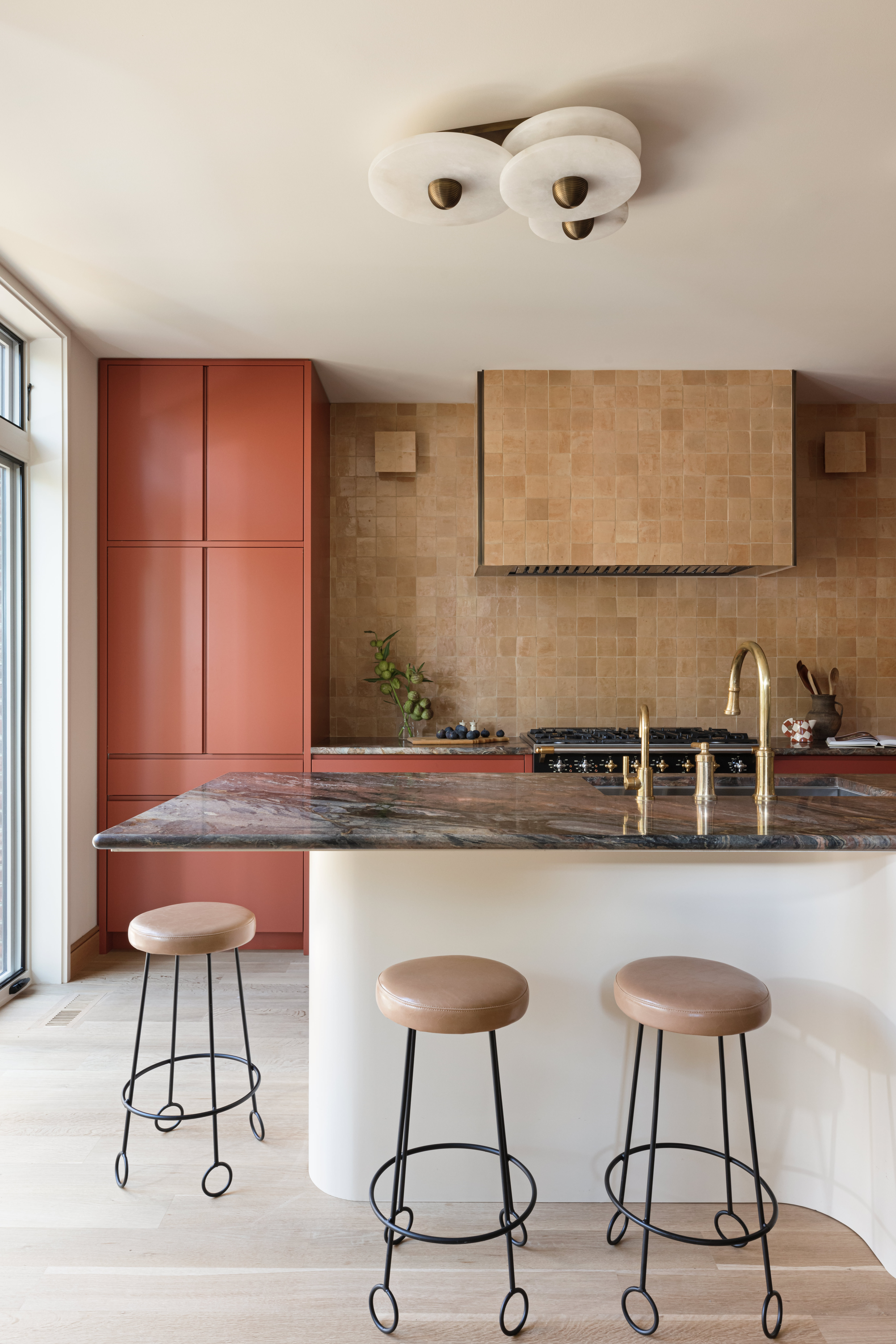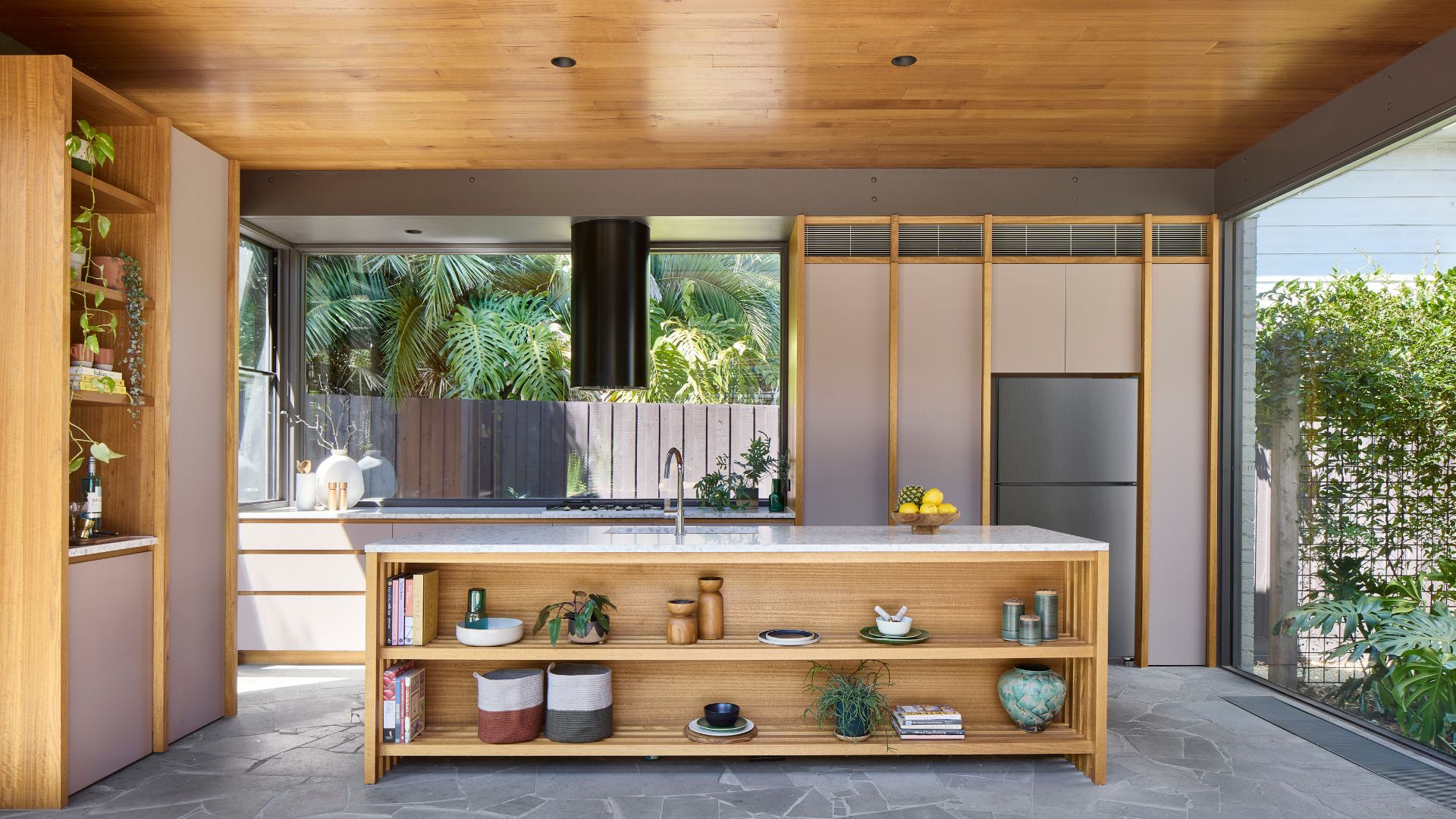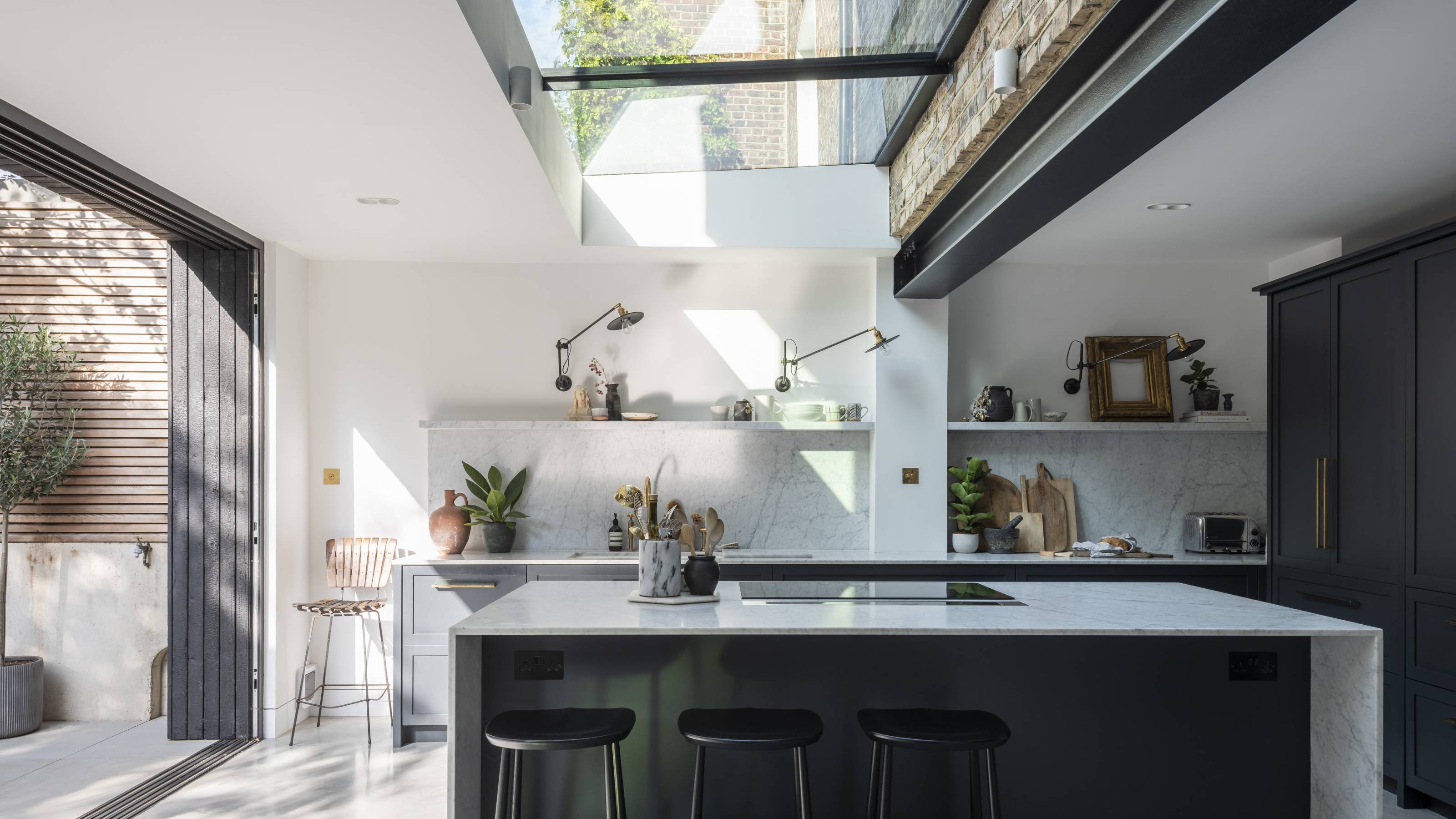How to Reduce Humidity in Your Kitchen — 8 Ways to Fight Off Moisture and Damp in Your Cooking Space
From range hoods and fans to moisture-loving plants, these expert tips will ensure your kitchen is refreshingly dry


Humidity and kitchens aren't a match made in heaven, but this natural phenomenon appears to be drawn to this culinary space like we are to gorgeous design-led homes. The downside to humidity's unassuming consequence is its effect on the interior environment. While it may seem like a little water-saturated air could do no harm, the repercussions are slow to build and tough to rid once they set in.
To keep from having to revamp your humid hotspot of a kitchen when it reaches the point of no return, we suggest enforcing some basic home maintenance tips to save your kitchen from becoming musty. By keeping an eye on your winter home humidity and adjusting your routine based on our experts' advice, you'll save yourself the trouble of a kitchen cloaked in condensation.
The tips to follow are easy to adopt and will not in any form take away from the aesthetics of this cooking zone. In fact, they will preserve the functionality, efficiency, and beauty of this room. So if you're wrestling with an over-humid kitchen, here's what you need to do.
1. Rely on Your Range Hood

In conversation with Josh Mitchell, HVAC technician and owner at Air Conditioner Lab, he tells us that it's best to always use a range hood while cooking. Even more so when you're boiling water and frying food.
"A well-functioning range hood can reduce moisture from cooking by up to 40-50%," he explains. "Ensure the hood vents are outside instead of recirculating air, and clean the filters every few months to maintain efficiency."
If your kitchen doesn't have a range hood, he tells us to consider installing an under-cabinet ductless hood with a charcoal filter as a temporary solution. We also find that investing in a portable range hood is another brilliant backup option.
2. Open Up Your Windows

John Wilson, founder of Wilson Plumbing & Heating, tells us that proper ventilation is extremely helpful in the mission of tamping down humidity levels. "When the weather is nice, open windows to let fresh air in and reduce humidity," he suggests. "This helps create airflow and lowers moisture levels."
It's important to know how often to open windows in winter, as opening your windows is recommended for free-flowing air. Although it may tamper with your home's coziness, the wintry weather is likely to cause plenty of condensation, so a couple of gusts of cold air will be the least of your problems around this time of year.
3. Pop in a Portable Dehumidifier

Josh tells us that it's better to rely on closed-loop ventilation systems or dehumidifiers to dry out a room and control moisture. He recommends adding a portable dehumidifier in the kitchen to keep humidity between 30-50%, which is ideal for preventing mold and condensation.
"For smaller kitchens, this hOmeLabs 22-Pint Dehumidifier from Amazon is a great choice," he says. "Not only is it compact in form but also efficient in function."
John also affirms the benefits of a good dehumidifier. "Simply place a dehumidifier in the kitchen to remove excess moisture from the air," he says. "This is especially useful in humid climates."
4. Cook with Lidded Pots

Josh tells us that he's a big fan of implementing simple preventative measures to regulate humidity in the kitchen. "Small changes like cooking with lids on pots can make a difference," he advises. "Trapping steam reduces moisture release while also speeding up cooking times"
When possible, John also encourages using lids on pots to reduce steam. The best part is that there are plenty of chic cookware serving dishes that you can take from stove to table while keeping the lid on throughout to keep your food warm and your kitchen humidity-free.
5. Practice Proper Dishwashing Habits

Josh adds that proper dishwashing habits can also help. He recommends avoiding air-drying dishes in the kitchen, as this adds unnecessary moisture to the air.
"Use a drying rack near a window or under a ceiling fan to speed up evaporation," he suggests. "Or rely on the dishwasher's heat-dry cycle to handle the task without increasing humidity."
Kitchen ventilation is of utmost importance but managing the humidity in this space can be tricky. So even tiny, unsuspecting adjustments like using a dish rack can help. This Dorai Home Large Dish Pad from Amazon is surprisingly stylish and highly absorbent for quick dish drying.
6. Incorporate an Oscillating Fan

Josh tells us to install a ceiling fan or oscillating fan in the kitchen for better airflow in a home with minimal kitchen windows. He finds that these fans improve circulation and prevent moisture from settling on surfaces.
"Ceiling fans are particularly energy-efficient, using 80% less energy than an AC while moving the air through your home," he says. "Pair fans with exhaust systems or open windows for even better results."
We found this Force Power Air Circulator Fan from Walmart that would be ideally placed in a kitchen. With its bold blue hue and rose gold embellishments, it's prettier than most and easy to relocate at a moment's notice.
7. Decorate with Moisture-Loving Houseplants

Josh urges homeowners to consider incorporating moisture-absorbing plants like peace lilies or Boston ferns as kitchen decor. Aside from bringing gorgeous foliage indoors, the right selection of kitchen plants will do right by your space.
"These plants can reduce humidity levels naturally by absorbing water vapor through their leaves," he says. "Just be sure not to overwater them, as excess soil moisture can have the opposite effect."
While we do enjoy decorating with plants in a kitchen, John rightly points out that it's not clever to go overboard. "Too many plants can actually add humidity, so limit the number of plants in this space," he notes.
8. Inspect Plumbing for Water Leaks

Josh explains that it's also important to address structural and equipment issues. He finds that fixing leaks under sinks or around dishwashers is essential, as even a small drip can add 20 gallons of water to the air daily.
"I recommend regularly inspecting plumbing connections," he shares. "And use leak detection tools like this Zircon Leak Alert Water Detector from Amazon to catch problems early."
Out of all of the rooms in your home, your kitchen is most prone to receiving more than its fair share of humidity. As unfortunate as it is, it's also mostly unavoidable.
That's precisely why we recommend incorporating some of these tips into your culinary space. Aside from helping you combat the humidity levels of this home zone, it will also aid in making your kitchen a fresher, cleaner space on all fronts.
FAQs
Why is Humidity High in Kitchens?

According to Josh, kitchens naturally generate a lot of moisture through everyday activities. "Boiling a large pot of water for just 30 minutes can release up to 1.5 liters of water vapor while running a dishwasher adds even more," he explains.
Josh goes on to point out that poor ventilation worsens the issue, as moist air gets trapped in the room instead of being released outside.
"In fact, kitchens can contribute to as much as 25% of a home's total humidity levels, especially in homes without range hoods or exhaust fans," he notes. "This is why proper moisture management is important in this space."
Be The First To Know
The Livingetc newsletters are your inside source for what’s shaping interiors now - and what’s next. Discover trend forecasts, smart style ideas, and curated shopping inspiration that brings design to life. Subscribe today and stay ahead of the curve.

Amiya is a Home Wellness Writer at Livingetc. She recently graduated with a Masters Degree in Magazine Journalism from City, University of London, and has lent her words to beauty, fashion, and health sections of lifestyle publications including Harper’s Bazaar and Women’s Health. Her experience as a research analyst has equipped her with an eye for emerging trends. When she’s off the clock, she can be found reading, listening to music, or overanalyzing her latest Co-Star update.
-
 The Weighted Blanket That Doesn’t Make You Sweat (and the Eye Mask to Match)
The Weighted Blanket That Doesn’t Make You Sweat (and the Eye Mask to Match)Luxury has weight. And apparently, volcanic minerals
By Julia Demer
-
 What Is Biophilic Interior Design? I'm an Actual Biophilic Designer, and This Is How to Apply It to Your Home
What Is Biophilic Interior Design? I'm an Actual Biophilic Designer, and This Is How to Apply It to Your HomeA biophilic designer explains the core principles of this practice, and the easy ways you can apply it to your home's design
By Marianna Popejoy
-
 These Are the Dos and Don'ts of Bamboo Plant Placement — Follow This to Avoid Bad Feng Shui
These Are the Dos and Don'ts of Bamboo Plant Placement — Follow This to Avoid Bad Feng ShuiBy following the experts' guidance on where to place this houseplant you can usher luck, wealth, and prosperity into your home
By Lilith Hudson
-
 Is It Okay to Have a Mirror Facing a Door in Feng Shui? The Verdict Is In and It Just Might Surprise You
Is It Okay to Have a Mirror Facing a Door in Feng Shui? The Verdict Is In and It Just Might Surprise YouDecorating your home with mirrors calls for intention if you're dressing your space in accordance with Feng Shui. Here's what you should know.
By Amiya Baratan
-
 4 Things to Unpack as Soon as You Move House — For a Comfortable and Organized Fresh Start
4 Things to Unpack as Soon as You Move House — For a Comfortable and Organized Fresh StartIf you have a major move in the works and you're looking to prepare in advance, this is the starter kit you need to properly set up your new home.
By Amiya Baratan
-
 10 Decluttering Challenges to Have on Your Radar This Year — For a Tidier, More Mindful Home
10 Decluttering Challenges to Have on Your Radar This Year — For a Tidier, More Mindful HomeIf you're interested in transforming your home for the better, here are 10 decluttering challenges I recommend for a professionally tidy space.
By Amiya Baratan
-
 Biophilic Decluttering — What to Take Out of Your Home (and What to Put in) for a More Natural Home
Biophilic Decluttering — What to Take Out of Your Home (and What to Put in) for a More Natural HomeTry your hand at biophilic decluttering to ground your interiors, connect to the environment, and cure chronic clutter in one go. Here's how.
By Amiya Baratan
-
 The 10 Different Types of Kitchen Taps — And the Pros and Cons of Each One to Know Before You Pick
The 10 Different Types of Kitchen Taps — And the Pros and Cons of Each One to Know Before You PickFrom sleek pull-outs to vintage bridge taps, explore 10 kitchen tap styles that mix function, flair, and a splash of cool
By Linda Clayton
-
 How Much Does an Extension Cost in 2025? Renovation and Design Experts Break Down Your Budget
How Much Does an Extension Cost in 2025? Renovation and Design Experts Break Down Your BudgetExplore how much different types of extensions cost in 2025 to budget for your project accurately
By Amy Reeves
-
 9 Bathroom Storage Mistakes You're Probably Making That Make Using This Space Much Harder — And What to Do Instead
9 Bathroom Storage Mistakes You're Probably Making That Make Using This Space Much Harder — And What to Do InsteadDiscover which mistakes are to blame for your overcrowded and cluttered bathroom
By Seraphina Kyprios